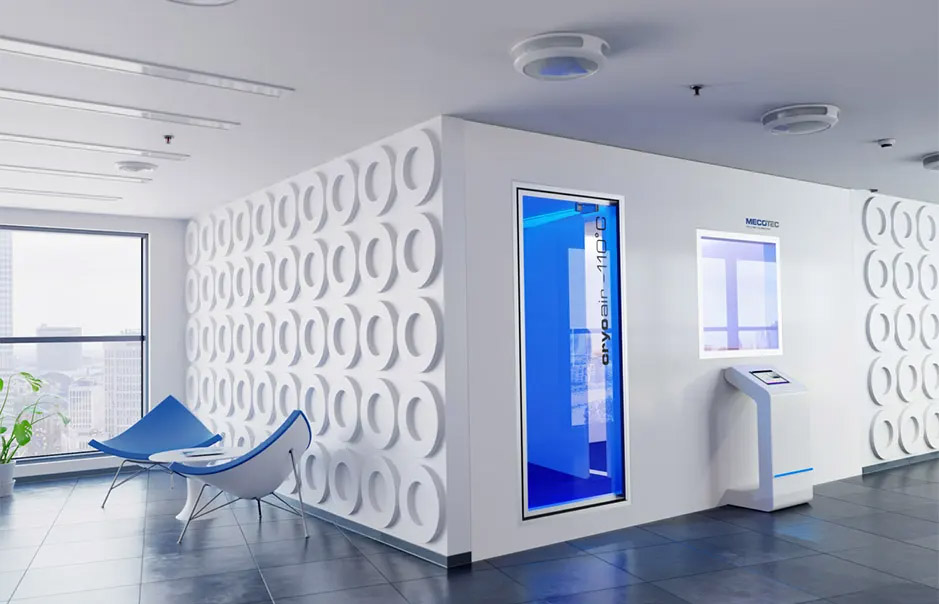Understanding the Technology Behind Electric Cryotherapy Chambers
Understanding the Technology Behind Electric Cryotherapy Chambers
Introduction to electric cryotherapy
Electric cryotherapy is a modern twist on the cold therapy trend that's been used for centuries to ease muscle pain and boost recovery. Instead of using icy water or cold air blasts, these chambers use electrically cooled air. This means you can step into a booth that looks a bit like a futuristic cylinder, and in just a few minutes, experience temperatures as low as -110°C (-166°F). Why go through with it? Well, the extreme cold is believed to help reduce inflammation, release endorphins, and speed up recovery time. It's a chill session literally taken to the next level. Unlike traditional methods, electric cryotherapy offers precise temperature control, making it a safe and efficient option for those looking to tap into the benefits of cold therapy without getting wet or spending too long in the cold. So, when you're ready to cool down your muscles in a sci-fi kind of way, electric cryotherapy is the path to take.
The evolution of cryotherapy technology
Cryotherapy started with ice baths, a basic but brutal way to reduce muscle soreness. Then came whole-body cryotherapy (WBC) in the late 1970s in Japan. It was a game changer. Early versions were crude, but the idea was solid: use extreme cold to help heal and rejuvenate the body. Fast forward, and the tech got smarter. We now have electric cryotherapy chambers that ditch the old nitrogen-cooled method. This shift means a safer, more controlled cold environment. These chambers use electric power to chill the air to temperatures as low as -140°C (-220°F). You get the same benefits—reduced inflammation, quicker muscle recovery, better skin—without the risk of nitrogen burns. Plus, these electric models are better for the environment and easier to use, making cold therapy accessible to more people. It's a leap from ice baths to high-tech healing, showing how far we've come in understanding and harnessing the power of cold.
How do electric cryotherapy chambers work?
Electric cryotherapy chambers work by cooling the air around you, but not with nitrogen gases which are common in many cryotherapy treatments. Instead, these chambers use electric systems to cool the air to temperatures between -110°C and -140°C (-166°F to -220°F). When you step into the chamber, sensors determine the optimal temperature based on your profile. Then, electric coils or compressors cool the air inside the chamber rapidly. The cold air swirls around your body, triggering a sudden drop in skin temperature. This sudden chill sends signals to your brain, saying, "Hey, it's really cold here!" Your brain responds by putting your body into survival mode, which means increasing blood flow to vital organs and reducing inflammation throughout the body. This process can help with muscle recovery, pain relief, and even boost your mood. Unlike nitrogen chambers, electric chambers are considered safer because they eliminate the risk of nitrogen burns and allow your head to remain outside the chamber, making it easier to breathe normal air. So, you get all the chilly benefits without the frosty drawbacks.
Key components of an electric cryotherapy chamber
Electric cryotherapy chambers might sound complicated, but they're made up of a few key components that make all the cold magic happen. First up, we've got the cooling system. This is the heart of the chamber; it uses electric power to cool the air inside the chamber to temperatures as low as -140 degrees Celsius. That's colder than winter in Antarctica! Next, there's the control panel. This is where you, or the person operating the machine, get to set the temperature and time for how long you want to brave the cold. It's all digital, easy to use, and lets you customize your icy experience.
Then, we can't forget about the safety features. These chambers come equipped with sensors and emergency shut-off options because, let's face it, hanging out in super cold temperatures can get risky. The chamber makes sure you're not in there for too long or at a dangerous temperature. Lastly, there's the chamber itself - the space you step into. It's designed to keep the cold in and the warmth out, all while making sure you're comfortable and safe. Together, these components work hand in hand to give you the chill thrill of cryotherapy without any frostbite.
The science of cold: Understanding thermodynamics in cryotherapy
Cryotherapy uses extremely cold temperatures to promote healing and wellness, but how does this chilly treatment actually work? It all boils down to thermodynamics, the study of how heat moves between objects. In cryotherapy, when your body is exposed to cold, it tries to protect its core temperature. Blood vessels constrict, slowing blood flow to areas that are freezing. This is your body's way of keeping your vital organs warm. Meanwhile, once you step out of the cryotherapy chamber, blood rushes back to those areas, bringing with it nutrients and oxygen. This sudden change stimulates healing, reduces inflammation, and can even boost your mood. So, the cold isn't just making you shiver; it's kickstarting a whole chain reaction that benefits your health. Cool, right?
Safety features and protocols in electric cryotherapy
Electric cryotherapy chambers come with cutting-edge safety features and protocols to ensure your wellness adventure is as risk-free as possible. First off, they're equipped with sensors to monitor the temperature in real-time, keeping it in the safe zone that brings benefits without harm. Also, there are oxygen sensors at the bottom of the chamber to make sure you're breathing air with enough oxygen, as the chamber is cooled to low temperatures. Next, an anti-freeze system kicks in to prevent any frostbite or cold burns on your skin. Before diving into the frosty experience, there's usually a pre-screening process to check if you're fit for cryotherapy, focusing on your medical history and any conditions that could raise red flags. You're not going in blind either. There will be an operator guiding you through the process, ready to stop the session at any hint of discomfort. Remember, sessions are short, lasting only a couple of minutes, limiting the risk of hypothermia. In a nutshell, electric cryotherapy chambers are designed with your safety as the top priority, so you can chill, quite literally, without worry.
Benefits of using electric cryotherapy chambers
Using electric cryotherapy chambers offers several benefits that can appeal to anyone looking to improve their health and well-being. First off, these chambers are known for reducing inflammation and pain. Whether you're an athlete recovering from a hard workout or someone suffering from chronic pain, the cold temperatures help decrease inflammation and thereby reduce pain. Next, let's talk about boosting recovery. By exposing your body to extreme cold, you're essentially speeding up the muscle recovery process, which is vital for athletes and fitness enthusiasts. Another important benefit is the improvement of sleep patterns. Individuals who go through sessions in electric cryotherapy chambers often report better sleep quality. This could be due to the reduction in pain and muscle soreness leading to a more relaxed state conducive to sleep. Lastly, electric cryotherapy chambers aid in enhancing mood and mental well-being. The cold exposure triggers the release of adrenaline, endorphins, and norepinephrine, which can lead to a feeling of euphoria, making you feel happier and more energetic. So, in a nutshell, using an electric cryotherapy chamber could help you feel less pain, recover faster, sleep better, and even boost your mood. Quite the package, isn't it?
Real-world applications: Who uses electric cryotherapy?
Athletes swear by it, fitness enthusiasts are curious about it, and celebrities highlight it in their wellness routines. Electric cryotherapy chambers are not just futuristic gadgets from a sci-fi movie; they're here, and they're being used right now, across various fields, to boost recovery and enhance performance. So who really uses these chilly pods of innovation? First off, professional athletes from footballers to track stars harness the power of electric cryotherapy to speed up their recovery after intense training sessions. This rapid recovery means they can train harder and more frequently, giving them an edge in their respective sports. Next up, fitness buffs. The everyday gym-goer looking to ease muscle soreness or boost their recovery process often steps into these cold chambers, trusting the process to keep them in top shape. But it's not just about physical recovery; mental wellness is on the menu too. People battling with sleep disorders or seeking a mental refresh find solace in the brief, yet intense, embrace of subzero temperatures. Then there's the beauty and wellness sector, where electric cryotherapy has carved out its niche. From boosting skin elasticity to promoting weight loss by accelerating metabolism, the allure of potential anti-aging effects draws in those looking to add a chill factor to their beauty regime. Celebrities often share their cryo-experiences, citing benefits like improved skin tone and reduced signs of aging, adding a glam factor to the science of cold. In essence, electric cryotherapy transcends its cool factor, proving its worth in sports, fitness, wellness, and beauty, making it a sought-after technology across various real-world applications.
Comparing electric cryotherapy chambers with traditional methods
Electric cryotherapy chambers have shifted the game from the traditional nitrogen-cooled methods. In traditional chambers, liquid nitrogen chills the air, dropping the temperature to between -100°C and -150°C . It's cold, yes, but there's also a slight risk of nitrogen exposure. Electric chambers, on the flip side, get cold using electric refrigeration to hit similar low temperatures. This means no direct nitrogen exposure, making it a safer bet for some. Now, let's talk efficiency. Both types chill you to the core, aiming to boost recovery, ease pain, and maybe even perk up your mood. But, with electric chambers, the cold is more even, without the cold spots that sometimes happen with nitrogen. Cost-wise, going electric might pull more from your wallet at the start. However, considering the reduced need for constantly buying nitrogen, the electric route could ease up on your budget over time. So, choosing between electric and traditional comes down to what you prioritize: the initial setup cost, safety concerns with nitrogen, or maybe just how evenly you want your cold therapy. Electric cryotherapy is stepping into the future with innovations that promise to make these chilly treatments more accessible and effective. Key trends include smarter, more energy-efficient chambers. Think of chambers that adjust the cold based on your body's response, using less power but giving a personalized chill. Also, expect to see compact designs making cryo-beginnings as easy as a coffee maker on your countertop. Wearable tech will likely sync with these chambers, letting you track your recovery metrics in real-time. It's all about getting that cold therapy down to a science, but in a way that fits into daily life seamlessly. With these leaps, the future looks cool, literally.
Future of electric cryotherapy: Innovations and trends
Toll Free
1-800-674-8260Use the form below to contact us for a quote, today.


